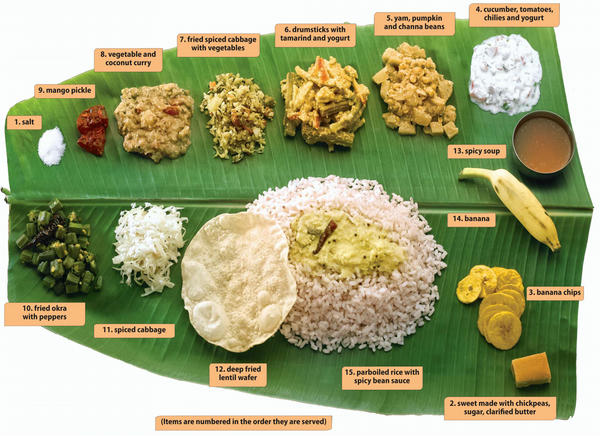Eating: Indian Style
The vegetarian meal at the right may look like a feast, but skilled ammas (mothers) prepare some variation of it every day for their families. This traditional South Indian spread is centered around rice. North Indians enjoy wheat-based flatbreads in place of or along with their rice, but the other dishes are similar. Lots of spices are used, including coriander, fenugreek, cumin, cayenne, cardamom, ginger, cloves, chili pepper, black pepper and cinnamon. Depending on the region, spicing may be mild to very hot.§
The meal is served in several courses on a banana leaf freshly cut and washed or, more commonly today, on a round metal plate. After washing your hands, you proceed to eat with the fingers of your right hand by taking a small amount of one or two of the vegetable items, mixing them with some rice and popping them in your mouth. Seconds are automatic. In fact, you can only get the host to stop serving more food by covering the leaf with your hands. Water or a cool beverage, such as lassi (a salted or fruit-juice-sweetened yogurt drink), may be served at the end. When finished, you fold your leaf in half, top to bottom. In the villages, the leaves, complete with leftovers, are fed to appreciative cows. Nothing goes to waste, and no plates to wash! After the meal, water is brought for cleaning your hands.§
Fingers, Forks and Chopsticks
There are three methods of eating in the world: with forks, with fingers and with chopsticks. Forks predominate in Europe, Australia and North America. Chopsticks are used in East Asia. Fingers are the most widespread eating implement, prevailing in India, Sri Lanka, Indonesia, the Middle East and much of Africa. Globally, fork-feeders are outnumbered more than two to one.§
Chopsticks have a venerable history, dating back to 1200 BCE. Forks were introduced to Europe in the 11th century CE by a Byzantine princess who married an Italian. She outraged the Italians by refusing to eat with her hands. A Catholic priest pointed out that “God in his wisdom has provided man with natural forks—his fingers.” The rest of Europe was slow to adopt forks. Many royalty, including Queen Elizabeth I and Louis XIV, used their fingers.§
1. Compare: After reading about a traditional South Indian lunch and looking at the images above, compare and contrast it with lunch in your own culture. How are your food and customs similar? How are they different?§
2. Evaluate: How do you usually eat food: with fingers, chopsticks or forks? List some advantages and disadvantages of these different ways of eating.§


